非谓语(-ing形式)
- 格式:doc
- 大小:52.00 KB
- 文档页数:2
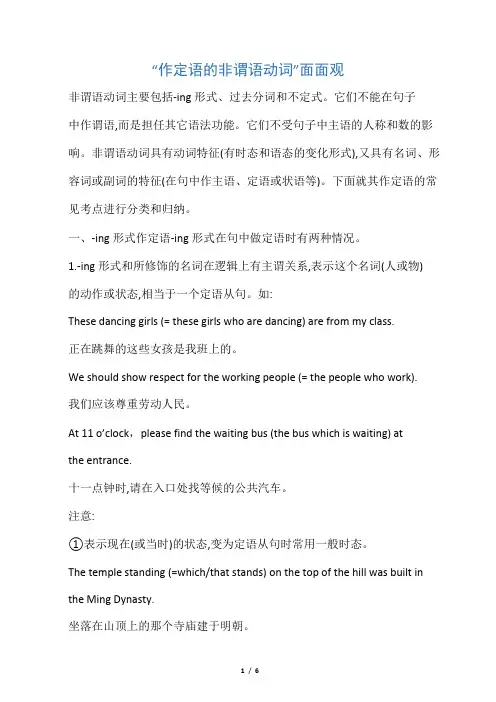
“作定语的非谓语动词”面面观非谓语动词主要包括-ing形式、过去分词和不定式。
它们不能在句子中作谓语,而是担任其它语法功能。
它们不受句子中主语的人称和数的影响。
非谓语动词具有动词特征(有时态和语态的变化形式),又具有名词、形容词或副词的特征(在句中作主语、定语或状语等)。
下面就其作定语的常见考点进行分类和归纳。
一、-ing形式作定语-ing形式在句中做定语时有两种情况。
1.-ing形式和所修饰的名词在逻辑上有主谓关系,表示这个名词(人或物)的动作或状态,相当于一个定语从句。
如:These dancing girls (= these girls who are dancing) are from my class.正在跳舞的这些女孩是我班上的。
We should show respect for the working people (= the people who work).我们应该尊重劳动人民。
At 11 o’clock,please find the waiting bus (the bus which is waiting) atthe entrance.十一点钟时,请在入口处找等候的公共汽车。
注意:①表示现在(或当时)的状态,变为定语从句时常用一般时态。
The temple standing (=which/that stands) on the top of the hill was built in the Ming Dynasty.坐落在山顶上的那个寺庙建于明朝。
②表示正在进行的动作,变为定语从句时要用进行时态。
Do you see the woman talking to (=who/that is talking to) the secretary?你看见那位和秘书谈话的妇女了吗?The song being broadcast (=which/that is being broadcast) is very popularwith the young students.正在播放的那首歌深受青年学生的欢迎。
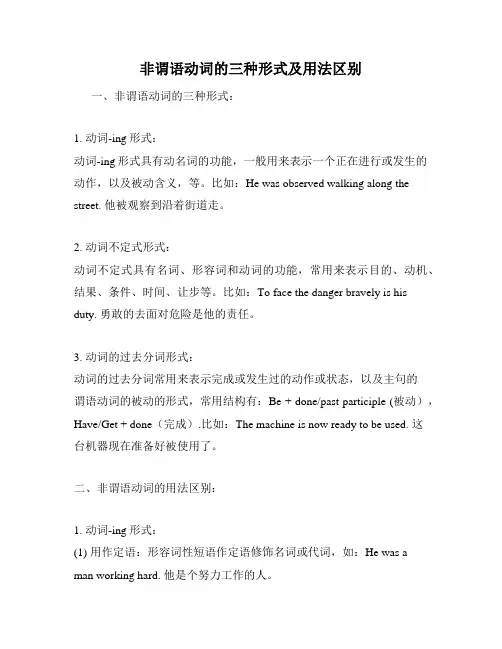
非谓语动词的三种形式及用法区别一、非谓语动词的三种形式:1. 动词-ing形式:动词-ing形式具有动名词的功能,一般用来表示一个正在进行或发生的动作,以及被动含义,等。
比如:He was observed walking along the street. 他被观察到沿着街道走。
2. 动词不定式形式:动词不定式具有名词、形容词和动词的功能,常用来表示目的、动机、结果、条件、时间、让步等。
比如:To face the danger bravely is his duty. 勇敢的去面对危险是他的责任。
3. 动词的过去分词形式:动词的过去分词常用来表示完成或发生过的动作或状态,以及主句的谓语动词的被动的形式,常用结构有:Be + done/past participle (被动),Have/Get + done(完成).比如:The machine is now ready to be used. 这台机器现在准备好被使用了。
二、非谓语动词的用法区别:1. 动词-ing形式:(1) 用作定语:形容词性短语作定语修饰名词或代词,如:He was aman working hard. 他是个努力工作的人。
(2) 用作表语:Ing 形式的短语作表语,表示一个正在进行的动作或状态,如:His job is repairing the machine. 他的工作是修理机器。
2. 动词不定式形式:(1) 作宾补:动词不定式作宾补表示“目的”,“动机”,“结果”,“条件”,“时间”,“让步”等。
如:He came here to do something for us. 他来这里为我们做一些事情。
(2) 作状语:动词不定式作状语,表示“目的”,“动机”,“条件”,“时间”,“让步”等。
如:She always goes out for a walk to relax herself. 她总是出去散步来放松自己。


非谓语动词——动词-ing形式动词的-ing形式也是一种非谓语动词。
-ing形式仍保留有动词的特征,可以带有其所需要的宾语或状语而构成-ing短语。
1、-ing的形式:-ing有一般式和完成式。
及物动词的-ing还有主动语态和被动语态,而不及物动词的-ing则没有被动语态。
现在以及物动词make 和不及物动词go为例,将其-ing各种形式列表如下:动词、语态形式及物动词make;不及物动词go主动语态被动语态主动语态一般式making being made going完成式having made h aving been made having gone2、-ing形式的基本用法。
(1)作主语:Seeing is believing.百闻不如一见。
Talking is easier than doing. 说着容易做着难–ing作主语时,可用it作形式主语,而将真正的主语-ing形式或短语后置。
如:It isn’t much good writing to them again.It’s no use waiting here.(2)作表语:Her job is washing and cooking.My hobby is collecting stamps.(3)作宾语:①作及物动词的宾语。
She likes drawing very much.;②作某些短语动词的宾语。
Mary is thinking of going back to New York.;③do+限定词(my, some, any, the等)+ -ing,表示“做…事”之意,如:We often do our cleaning on Saturday afternoon.Will you do any shopping on Saturday this afternoon?④作介词的宾语:Her sister is good at learning physics.;⑤作形容词worth, busy等的宾语:This book is well worth reading.–ing作宾语带有宾语补足语时,要用it作为形式宾语,而将作宾语的-ing后置,如:We found it no good talking like that.Do you think it necessary trying again?(4)作定语:The sleeping child is only five years old.Do you know the man standing at the gate?注:-ing形式作定语用时,如果-ing只是一个单词,就位于其修饰的名词之前,如果是-ing短语,就位于其修饰的名词之后;-ing作定语时,被-ing所修饰的名词就是该-ing的逻辑主语。
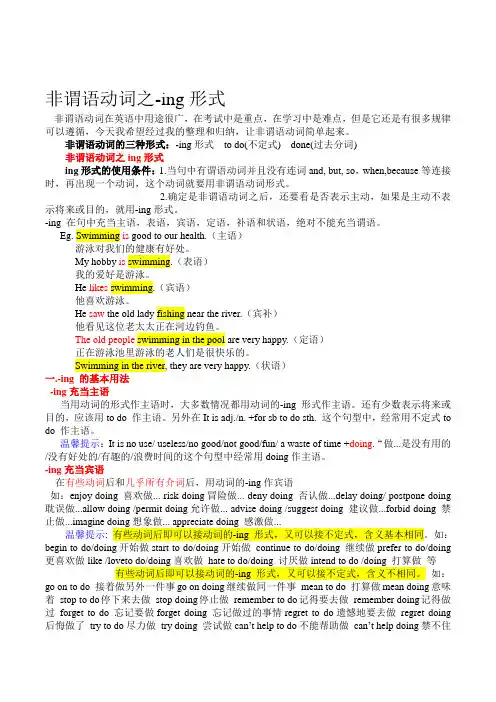
非谓语动词之-ing形式非谓语动词在英语中用途很广,在考试中是重点,在学习中是难点,但是它还是有很多规律可以遵循,今天我希望经过我的整理和归纳,让非谓语动词简单起来。
非谓语动词的三种形式:-ing形式to do(不定式) done(过去分词)非谓语动词之ing形式ing形式的使用条件:1.当句中有谓语动词并且没有连词and, but, so,when,because等连接时,再出现一个动词,这个动词就要用非谓语动词形式。
2.确定是非谓语动词之后,还要看是否表示主动,如果是主动不表示将来或目的,就用-ing形式。
-ing 在句中充当主语,表语,宾语,定语,补语和状语,绝对不能充当谓语。
Eg. Swimming is good to our health.(主语)游泳对我们的健康有好处。
My hobby is swimming.(表语)我的爱好是游泳。
He likes swimming.(宾语)他喜欢游泳。
He saw the old lady fishing near the river.(宾补)他看见这位老太太正在河边钓鱼。
The old people swimming in the pool are very happy.(定语)正在游泳池里游泳的老人们是很快乐的。
Swimming in the river, they are very happy.(状语)一.-ing 的基本用法-ing充当主语当用动词的形式作主语时,大多数情况都用动词的-ing 形式作主语。
还有少数表示将来或目的,应该用to do 作主语。
另外在It is adj./n. +for sb to do sth. 这个句型中,经常用不定式to do 作主语。
温馨提示:It is no use/ useless/no good/not good/fun/ a waste of time +doing.“做...是没有用的/没有好处的/有趣的/浪费时间的这个句型中经常用doing作主语。
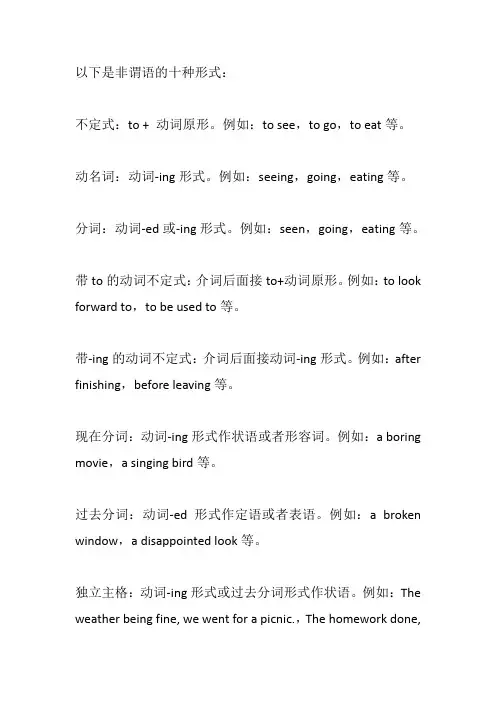
以下是非谓语的十种形式:
不定式:to + 动词原形。
例如:to see,to go,to eat等。
动名词:动词-ing形式。
例如:seeing,going,eating等。
分词:动词-ed或-ing形式。
例如:seen,going,eating等。
带to的动词不定式:介词后面接to+动词原形。
例如:to look forward to,to be used to等。
带-ing的动词不定式:介词后面接动词-ing形式。
例如:after finishing,before leaving等。
现在分词:动词-ing形式作状语或者形容词。
例如:a boring movie,a singing bird等。
过去分词:动词-ed形式作定语或者表语。
例如:a broken window,a disappointed look等。
独立主格:动词-ing形式或过去分词形式作状语。
例如:The weather being fine, we went for a picnic.,The homework done,
he went out to play.
不定式短语:不定式作主语、宾语、表语、定语等。
例如:To learn English well is important.,I want to eat some fruit.
分词短语:分词作定语、状语、表语等。
例如:A sleeping baby,The story told by him.。
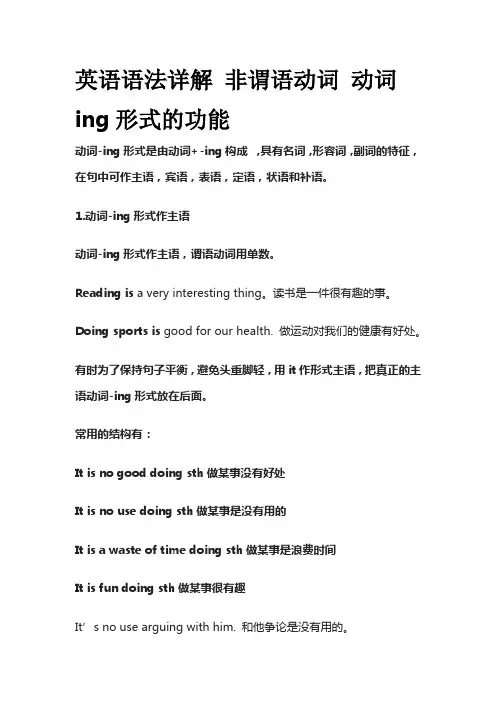
英语语法详解非谓语动词动词ing形式的功能动词-ing形式是由动词+-ing构成,具有名词,形容词,副词的特征,在句中可作主语,宾语,表语,定语,状语和补语。
1.动词-ing形式作主语动词-ing形式作主语,谓语动词用单数。
Reading is a very interesting thing。
读书是一件很有趣的事。
Doing sports is good for our health. 做运动对我们的健康有好处。
有时为了保持句子平衡,避免头重脚轻,用it作形式主语,把真正的主语动词-ing形式放在后面。
常用的结构有:It is no good doing sth做某事没有好处It is no use doing sth做某事是没有用的It is a waste of time doing sth做某事是浪费时间It is fun doing sth做某事很有趣It’s no use arguing with him. 和他争论是没有用的。
2.动词-ing形式作宾语动词-ing形式可以作一些及物动词的宾语,也可以用作介词的宾语。
一般只跟动词-ing形式作宾语的动词有:admit(承认)appreciate (感激)avoid(避免)delay(推迟)deny(否认)risk(冒险)enjoy (喜欢)escape(逃跑)excuse(原谅)finish(完成)imagine(想象)keep(继续)include(包括)mind(介意)miss(错过)practice (练习)resist(抵制)suggest(建议)put off(推迟)cannot help (禁不住)feel like(想要)insist on(坚持)He suggested going to see a film. 他建议去看电影。
He admitted cheating in the exam. 他承认在考试中作弊。
有些动词既可以跟-ing形式作宾语,也可以跟不定式作宾语。
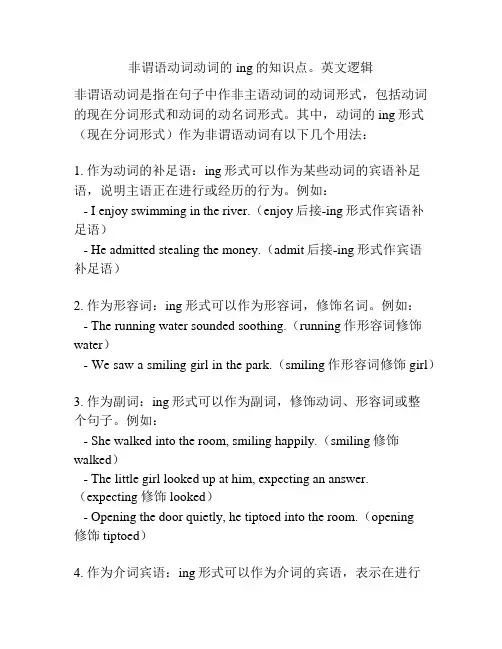
非谓语动词动词的ing的知识点。
英文逻辑非谓语动词是指在句子中作非主语动词的动词形式,包括动词的现在分词形式和动词的动名词形式。
其中,动词的ing形式(现在分词形式)作为非谓语动词有以下几个用法:1. 作为动词的补足语:ing形式可以作为某些动词的宾语补足语,说明主语正在进行或经历的行为。
例如:- I enjoy swimming in the river.(enjoy后接-ing形式作宾语补足语)- He admitted stealing the money.(admit后接-ing形式作宾语补足语)2. 作为形容词:ing形式可以作为形容词,修饰名词。
例如:- The running water sounded soothing.(running作形容词修饰water)- We saw a smiling girl in the park.(smiling作形容词修饰girl)3. 作为副词:ing形式可以作为副词,修饰动词、形容词或整个句子。
例如:- She walked into the room, smiling happily.(smiling修饰walked)- The little girl looked up at him, expecting an answer.(expecting修饰looked)- Opening the door quietly, he tiptoed into the room.(opening修饰tiptoed)4. 作为介词宾语:ing形式可以作为介词的宾语,表示在进行某个动作时伴随的动作。
例如:- She went to the park, taking her dog with her.(taking作介词with的宾语)此外,动词的ing形式也可以与助动词be构成进行时态,表示正在进行的动作。
例如:- She is reading a book.(reading作进行时态的动词)需要注意的是,动名词(-ing形式作为名词)和现在分词(ing形式作为非谓语动词)在形式上相同,但在句法和含义上有区别。


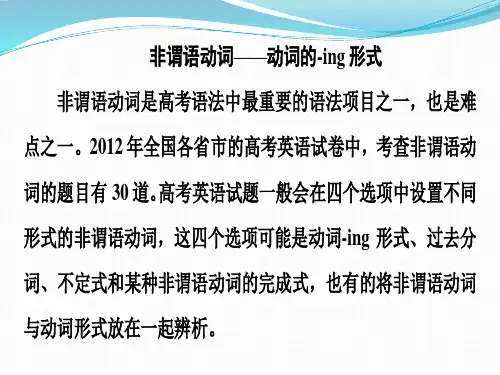
非谓语动词讲解以及例句非谓语动词是指动词的非谓语形式,不受主语的人称和数的限制,常用作句子的宾语、定语或状语。
非谓语动词包括动名词、不定式和分词三种形式。
一、动名词(-ing形式):1. 作主语:Being kind to others is always a good thing to do.(对他人友善总是值得做的好事。
)2. 作宾语:I enjoy swimming in the ocean.(我喜欢在海里游泳。
)3. 作宾补:She made a decision, ending their relationship.(她做出了一个决定,结束了他们的关系。
)4. 作定语:The running water is so clear and refreshing.(流动的水非常清澈和令人神清气爽。
)5. 作状语:Knowing the answer, he raised his hand.(知道答案后,他举手了。
)二、不定式(to + 动词原形):1. 作主语:To learn a new language is challenging but rewarding.(学习一门新语言是具有挑战性但值得的。
)2. 作宾语:She wants to visit Paris next year.(她想明年去巴黎旅游。
)3. 作宾补:I need to finish this report by tomorrow.(我需要明天之前完成这份报告。
)4. 作定语:He is the best person to ask for help.(他是寻求帮助的最佳人选。
)5. 作状语:She went to the library to study.(她去图书馆学习。
)三、分词:1. 现在分词(-ing形式):The crying baby woke up the entire neighborhood.(哭闹的婴儿吵醒了整个社区。
非谓语动词(一)- ing分词1. -ing分词的构成-ing分词是由动词原形加词尾-ing构成。
-ing分词同样有时态和语态的变化,通常有下表几种形式(以do为例):-ing分词的否定形式是由not 加-ing分词构成。
●Not knowing his address, I could do nothing but stay at home and wait.不知道他的地址,我只好在家里等着。
●His not coming made all of us angry. 他没来使我们大家都很生气。
(1) -ing分词的一般式和完成式:-ing分词的一般式表示和谓语动词所表示的动作同时进行的动作;完成式表示在谓语动词所表示的动作之前发生的动作。
●Being a student, he was interested in books. 作为一个学生,他对书本很感兴趣。
●Not having studied his lessons very hard, he failed the examinations. 因为没有努力学习功课,他考试不及格。
(2) -ing分词的被动式:-ing分词的被动式表示它的逻辑主语是-ing分词动作的承受者。
根据-ing分词动作发生的时间,-ing分词的被动式有一般被动式(being done)和完成被动式(having been done)。
●The question being discussed is very important. 正在被讨论的问题很重要。
●He never talked about his having been interviewed by the reporter. 他从来没谈起过他被记者采访的事情。
●Having been criticized by the teacher, he gave up smoking. 被老师批评以后,他把烟戒了。
非谓语动词用法解析动词ing作目的状语非谓语动词用法解析:动词-ing作目的状语动词-ing作目的状语是非谓语动词的一种常见用法。
在句子中,动词-ing形式可以作为目的状语,表示主语的动作或状态的目的或用途。
本文将对非谓语动词-ing作目的状语的用法进行详细解析。
一、形式动词-ing作目的状语的形式为动词的现在分词形式,即动词原形 + ing。
例如:1. I went shopping to buy some groceries.我去购物是为了买些杂货。
2. She stayed up late to finish her project.她熬夜是为了完成她的项目。
3. They studied hard to pass the exam.他们努力学习是为了通过考试。
二、用法1. 表示主语的目的或用途动词-ing作目的状语可以说明主语进行某个动作或处于某种状态的目的或用途。
例如:1. They traveled to experience different cultures.他们旅行是为了经历不同的文化。
2. The students worked hard to earn good grades.学生们努力学习是为了获得好成绩。
3. He went to the gym to build muscle.他去健身房是为了增肌肉。
2. 与动词不定式互换有些句子可以使用动词-ing作目的状语或动词不定式作目的状语,表示相同的意思。
这时候,动词-ing往往更常用于口语或非正式场合。
例如:1. He went to the store to buy milk. 或 He went to the store buying milk.他去商店是为了买牛奶。
2. She came to the party to meet new people. 或 She came to the party meeting new people.她来参加派对是为了结识新的人。
词法:非谓语动词之动词的-ing形式动词的-ing形式包括现在分词和动名词。
具有名词、代词、形容词、副词的特征,同时还具有动词的某些特征,在句中可作主语、表语、宾语、宾补、主补、定语和状语。
1.动词的-ing形式的时态与语态动词的-ing形式保留着动词的若干特征,又具有形容词、副词的特征,有时态和语态变化。
其时态和语态的形式如下所示:①主动语态的一般式:doing被动语态的一般式:being done其否定形式是在doing之前加上not②主动语态的完成式:having done被动语态的完成式:having been done其否定形式是在doing之前加上not(1)一般式①表示泛指时间-ing形式的一般式表示的动作通常是一般性动作,即不是明确地发生在过去、现在或将来的动作。
I hate talking with such boastful people .Being careless is not a good habit , whatever you do .②表示与谓语同时发生的动作-ing形式的一般式可表示和谓语动词同时发生的动作。
The children surrouded the teacher , listening attentively to her story .Following the guide , we were walking into the deep virgin forest .③表示发生在谓语动词之前的动作对于某些动词,我们常用-ing形式的一般式表示完成,尽管动作发生在谓语动词动作之前,这似乎已经成为一种习惯。
Excuse me for being late .I don't remember ever meeting you somewhere .Thank you for giving us so much help last time we were in Queens(纽约皇后区).④表示发生在谓语动词之后的动作Most doctors strongly insist on giving up smoking and taking plenty of exercises .(2)完成式-ing形式的完成式表示的动作发生在谓语动词之前。
动词-ing形式外,动词-ing形式还有复合结构,就是带有逻辑语的动词-ing形式,即sb(’s)doingsth。
2.动词-ing形式的句法功能动词-ing形式相当于名词、形容词和副词的用法,在句中可以充当主语、宾语、表语、定语、状语和补语。
1)作主语动词-ing形式作主语比较抽象,而动词不定式作主语比较具体。
动词-ing形式作主语一般用形式主语it.e.g.Looking (/ To look) after the children is their duty.Seeing is believing./ To see is to believe. 眼见为实。
It is no use helping them at this time.It is their duty looking after the children.It is foolish behaving like that.2)作宾语plan to visit Beijing (plan在先,visit在后) 一般可以后接动词-ing形式的及物动词和动词短语有advise, allow, resist, admit, escape, risk, avoid, forgive, suggest, consider, imagine, understand, delay, appreciate, enjoy, finish, mind, keep, can’t stand, excuse, miss, put off, practice, give up, deny, prevent等,另外介词后面的动词用-ing形式。
3)作表语动词-ing形式充当表语有两种用法。
一种是名词性用法,表示主语的内容;另一种是形容词性用法,表示主语的特性。
e.g.My job is looking (/to look) after the patient.My job is quite boring.4)作定语①说明被修饰名词的作用和用途,“动词-ing形式+名词”相当于“名词+for+动词-ing形式”。
否定形式:not doing/ not having done
例如:
⑴They couldn’t stand being treated like that.⑵The boy didn’t mind being left at home.
⑶I regret not having taken his advice. ⑷I didn’t remember having ever been given such a chance.
动名词:
一、作主语
eg.⑴Seeing is believing. To see is to believe. ⑵Smoking is bad for your health.
结构:It’s no use/no good/useless doing sth.It’s a waste of time doing sth.There is no doing sth. (…是不可能的)eg.⑴It’s no use talking too much.⑵There is no getting along with him. (他这个人很难相处)
二、动名词作表语
eg.⑴My job is teaching English. = Teaching English is my job.
⑵His greatest happiness is serving the people.= Serving the people is his greatest happiness.
三、动名词作宾语
eg.⑴He enjoys playing football. ⑵He left without saying goodbye to us. ⑶She makes a living by selling flowers. 只能接动名词作宾语的动词和词组有:
finish, mind, consider, practice, imagine, avoid, miss ,appreciate, escape, risk, admit, feel like, can’t help, give up, end up, can’t stand, be worth等
to为动名词的动词短语:
习惯于be/get used to 坚持stick to 反对object to 导致lead to 献身于devote to 喜欢prefer to
谈到come to 期待look forward to 加上add to开始get down to
在介词后面作宾语的词组有:
insist on, look forward to, be used to doing, be fond of, get down to(开始做某事), be interested in, spend…(in) doing sth, de vote…to…, object to(反对)等.
动名词的复合结构:
名词/名词所有格/形物/宾格+doing(动名词)
eg.They insisted on Tom/Tom’s /his/ him staying longer.
Tom’s / His coming is what we have expected.
③既可接动名词又可接动词不定式做宾语的动词有下面几种情况:
a)like, love, hate, continue)to do/doing
b)start(begin)to do/doing,当主语是物;含有进行体或这两个动词后面有情感动词时只能用to do.因此,首选to do.
c)remember(forget, regret)to do/doing, to do表示这个动作还没做;doing表示这个动作已做,已完成。
d)want(need, require)doing/to be done如:The classroom needs cleaning/to be cleaned.
e)be worth doing; be worthy of being done/to be done; It’s worthwhile to do/doing
f)go on to do something/doing something; try to do/doing; stop to do/doing; mean to do/doing; learn to do/doing(学会了做……);can’t help to do(对于做某事不能有所帮助)/doing something(情不自禁地做……)
四、动名词作定语
动名词作定语表示被修饰的名词的用途。
eg. ⑴a swimming pool= a pool which is used for swimming
⑵a walking stick = a stick which is used for waking
现在分词
一、现在分词作定语
1. 表示被修饰名词本身所具有的性质、特征。
⑴an amusing story= a story which amuses people.
⑵an interesting book= a book which interests people
2.表示被修饰名词正在进行的动作,并且
⑴the rising sun=the sun which is rising
⑵a sleeping boy= a boy who is sleeping
⑶The boy singing now is my brother.= The boy who is singing now is my brother.
⑷The temple standing at the foot of the hill is old.= The temple which stands at the foot of the hill is old.
二、现在分词作表语
eg.⑴The cake is very inviting (诱人的,吸引人的) ⑵The news was disappointing.
三、现在分词作宾语补助语
⑴When I passed by his house, I heard him playing the piano. ⑵I felt the house shaking.
⑶He kept me waiting for so long. ⑷I found him smoking. →He was found smoking.
接现在分词作宾语补助语的动词有:
see, watch, notice, observe, look at, hear, listen to, feel, get, have, leave, catch, find等。
四、现在分词作状语
1. He stood there. He read a book.→He stood there, and read a book.→He stood there, reading a book.
2. First he graduated from the college. Then he hunted for a job.
→Having graduated from the college, he hunted for a job.
现在分词短语作状语时,通常表示主语正在进行的另一个动作,用来对谓语动词表示的动作加以修饰,它可以表示时间,原因,结果,条件,让步,方式或伴随动作。
1.现在分词作时间状语, 相当于时间状语从句
(When) Walking in the street, he met one of his old friends.
2.作原因状语,相当于原因状语从句.
eg. ⑴Being ill, he stayed at home.
⑵Not knowing how to do it, he asked the teacher for help.
3.作条件状语,相当于条件状语从句.
eg.⑴Going straight, you will find the door.
⑵Working hard, you will succeed.
4. 作让步状语,相当于让步状语从句.
e.g. Ha ving failed several times, he didn’t lose heart.
5.作结果状语.
e.g. Her husband died, leaving her three children.
6. 作方式状语
e.g. Work out the problem, using another way.
7.作伴随状语,相当于并列句.
e.g. A little girl came in, singing and dancing.
独立成分:
to tell you the truth, supposing/providing/provided that…(如果,假使),compared to/with 和……相比较
e.g.⑴Generally speaking, this poem is good. 总的说来, 这首诗不错。
⑵Judging by his accent,he must be from Shandong.。